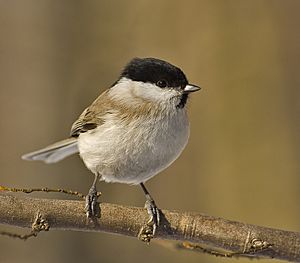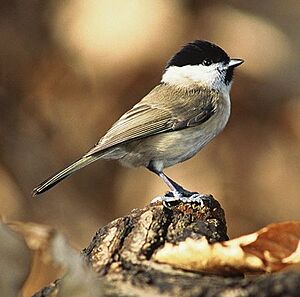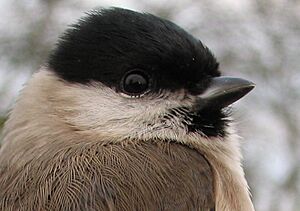Marsh tit facts for kids
Quick facts for kids Marsh tit |
|
|---|---|
 |
|
| Conservation status | |
| Scientific classification | |
| Genus: |
Poecile
|
| Species: |
palustris
|
 |
|
| Where the Marsh Tit lives Resident | |
The marsh tit (Poecile palustris) is a small bird found in Europe and Asia. It belongs to the tit family, which includes many well-known small birds. This bird is about 12 centimeters (about 5 inches) long and weighs around 12 grams (less than half an ounce).
It has a black cap on its head, a black patch under its beak, and pale cheeks. Its back is brown, and its wings and tail are greyish-brown. The marsh tit looks very similar to the willow tit, especially in the United Kingdom. For a long time, people didn't realize they were different species! They were finally recognized as separate birds in 1897.
Even though it's called a "marsh tit," this bird lives in many different places, not just marshes. You can find it in dry woodlands too. Marsh tits eat a variety of foods, including caterpillars, spiders, and seeds. They build their nests in holes in trees, often making existing hollows bigger instead of digging new ones. A female marsh tit usually lays between 5 and 9 eggs.
Globally, the marsh tit is not considered to be in danger. However, its numbers have been dropping in some areas, like the UK, where they have fallen by more than half since the 1970s.
Contents
About the Marsh Tit's Name
The marsh tit was first officially described by a Swedish scientist named Carl Linnaeus in 1758. He gave it the scientific name Parus palustris. Later, it was moved to the genus Poecile.
The name Poecile comes from an old Greek word for a small bird. It might mean "spotted." The word palustris is Latin and means "marshy," which is how the bird got its common name.
Scientists have studied the marsh tit's DNA. They found that it is closely related to other tits from Europe and Asia, like the willow tit and the Songar tit. There are about ten different types, or subspecies, of marsh tits found across its wide range.
What Does a Marsh Tit Look Like?
The marsh tit has a shiny black cap on its head and a small black patch under its beak. Its cheeks are white, and its upper body, tail, and wings are greyish-brown. The feathers on its underside are off-white, sometimes with a brownish tint. Its beak is black, and its legs are dark grey.
Young marsh tits look a lot like adult birds. Their black cap and bib are a bit duller, and their upper parts are more grey. They grow their adult feathers by September.
A marsh tit weighs about 12 grams (0.4 ounces). It is about 11.5 to 12 centimeters (4.5 to 4.7 inches) long from its beak to its tail. Its wings can spread about 19 centimeters (7.5 inches) wide. The oldest marsh tit ever recorded in Europe lived for almost 12 years!
Marsh Tit Sounds
Marsh tits make many different sounds, just like other tits. A common call is a sharp "pitchou" sound, especially when they are upset. This can sometimes lead into a "pitchou-bee-bee-bee" call.
Unlike many other tits, the marsh tit has a clear song with many different tunes. One common song sounds like a ringing "schip-schip-schip-schip-ship." Another is a more flowing "tu-tu-tu-tu-tu." They can also sing a sweet "tyeu-tyeu-tyeu-tyeu-tyeu." In some old English areas, people called this bird the "Saw Whetter" because of its scolding call.

It can be tricky to tell marsh tits and willow tits apart just by looking at them. In the UK, the local types of these two birds are very similar. One helpful clue is the pale "cutting edge" on the marsh tit's beak, which you can see if the bird is caught. Otherwise, the best way to tell them apart is by their calls.
Marsh tits usually have a shinier black cap and a smaller black patch under their beak. They also don't have the pale stripe on their wings that willow tits often have. However, these clues are not always perfect. Young marsh tits, for example, might have a pale stripe on their wings. Marsh tits also have a smaller, neater head compared to the willow tit.
It was so hard to tell them apart that willow tits were not recognized as a separate species in the UK until 1897! Two German bird scientists, Ernst Hartert and Otto Kleinschmidt, discovered the difference while studying bird skins.
Where Marsh Tits Live and Their Home
Marsh tits live across a huge area, covering about 10 million square kilometers (3.8 million square miles) worldwide. In Europe alone, there are between 6.1 million and 12 million marsh tits. Even though their numbers are dropping in some places, like the UK, they are still considered a common species overall.
In the UK, marsh tit numbers have fallen by more than 50% since the 1970s. This has put them on the "Red List" of species that need help. Scientists think this decline might be due to fewer birds surviving each year. Other studies suggest that changes in woodlands, like less variety in plants and shrubs due to deer eating them, make it harder for marsh tits to find suitable homes.
Marsh tits live in many parts of temperate Europe and northern Asia. You can find them from northern Spain all the way to southeastern Scotland and east to western Russia. They are also found in eastern Asia, from the Altai Mountains to northern Japan and parts of China.
These birds usually stay in the same area all year round. They don't tend to travel far, even in winter. Most marsh tits stay in their breeding territories. This is probably because they hide food for later. Studies show that most marsh tits are found less than 5 kilometers (3 miles) from where they were first caught. Young birds might join mixed groups of birds that roam around, but adult marsh tits usually stick to their own territory.
Marsh tits prefer to live in lowland areas. They like large areas of moist woodlands, especially those with oak or beech trees. They can also live in wet alder woodlands, trees along rivers, parks, gardens, and orchards. Studies have shown that marsh tits need mature trees with a layer of shrubs underneath. They tend to avoid areas with many young trees.
Marsh Tit Behavior and Life Cycle
In winter, marsh tits sometimes join mixed groups of other tit species. However, you usually only see one or two marsh tits in these groups. They are very neat and quick when moving through bushes and branches. They can even hang upside down by one leg!
Reproduction and Nesting
Marsh tits usually stay with the same partner for their whole lives. Some pairs have been known to stay together for six years!
They build their nests in holes. These holes are usually in trees, but sometimes they can be in walls or even in the ground. They might also use nest boxes. Marsh tits don't usually dig their own holes. Instead, they find an existing hollow and make it bigger. They carry away any wood chips so that no one knows where their nest is.
The nest hole can be very close to the ground or as high as 10 meters (33 feet) up. Inside the hole, they build a nest of moss and line it with hair and a few feathers. If the hole is damp, they might use a lot of moss, but less if it's dry.
Between five and nine white eggs with red speckles are laid in late April or May. Each egg is about 16 by 12 millimeters (0.6 by 0.5 inches) and weighs about 1.2 grams (0.04 ounces). The female bird sits on the eggs for 14 to 16 days. She starts sitting on them before all the eggs are laid, so the chicks hatch over a couple of days. If she is disturbed, she might make a hissing sound to scare away intruders.
The male marsh tit helps feed and care for the young birds. He brings almost all the food for the first four days after the chicks hatch. The baby birds are born without feathers and are helpless. They leave the nest after 18 to 21 days. Their parents continue to feed them for about a week after they fledge. The young birds become fully independent after another 1 to 7 days. The family stays together for about 11 to 15 days after the young birds start flying. It's very rare for marsh tits in Britain to have a second group of chicks in the same year.
Food and How They Eat
Marsh tits mainly eat spiders and insects in spring and summer. In autumn and winter, they switch to eating seeds, nuts, and berries. They especially love beech nuts when they can find them. Marsh tits often pick seeds and fruits from plants and then carry them away to eat in a safer place.
These birds are very good at collecting and storing large amounts of seeds. One study in Norway watched marsh tits for over two hours. They ate 43 seeds and hid 83 seeds in just one hour! In Sweden, they hide food most often between September and late February, with the most hiding happening in September and October.
They hide seeds in many places: on the ground, in leaf litter, in tree stumps, and under moss and lichen on trees. Other birds, or even other marsh tits, might try to steal their hidden food. So, marsh tits often fly from one spot to another before choosing a hiding place. They tend to find the oldest hidden items first. They remember where they hid the food instead of just searching randomly. The part of the marsh tit's brain that helps with memory, called the hippocampus, is bigger than that of the great tit. This is even though the great tit is a larger bird overall. This bigger brain part helps marsh tits remember all their hidden food spots!




